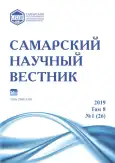Активность каталазы травянистых растений в условиях загрязнения городской среды
- Авторы: Петухов А.С.1, Хритохин Н.А.1, Кремлева Т.А.1, Петухова Г.А.1
-
Учреждения:
- Тюменский государственный университет
- Выпуск: Том 8, № 1 (2019)
- Страницы: 90-95
- Раздел: 03.02.00 – общая биология
- URL: https://journals.rcsi.science/2309-4370/article/view/21588
- DOI: https://doi.org/10.17816/snv201981115
- ID: 21588
Цитировать
Полный текст
Аннотация
Поступающие в клетки растений поллютанты способны вызывать биохимические нарушения, в том числе перекисное окисление липидов, что приводит к изменению активности антиоксидантной системы. Поддержание окислительно-восстановительного равновесия в клетках является необходимым условием выживания растений в условиях антропогенного загрязнения. Целью работы было изучение активности каталазы в мятлике луговом, мышином горошке, клевере красном, мать-и-мачехе и ромашке вблизи различных промышленных предприятий г. Тюмени. Растения были собраны вблизи автотрассы, а также в районах аккумуляторного, моторостроительного, нефтеперерабатывающего и металлургического предприятий. Изменение активности каталазы в клетках растений оказалось видоспецифичным. В клетках мятлика лугового и мышиного горошка наблюдалось снижение активности каталазы, а в мать-и-мачехе, клевере красном и ромашке - как снижение, так и активация фермента. Поллютанты всех изученных предприятий оказывали в той или иной степени влияние на активность каталазы, однако наибольший эффект был зарегистрирован вблизи металлургического завода, что, вероятно, связано с высоким поступлением тяжелых металлов в растения. Наименьшее воздействие на активность каталазы по сравнению с контролем было обнаружено вблизи автотрассы.
Полный текст
Открыть статью на сайте журналаОб авторах
Александр Сергеевич Петухов
Тюменский государственный университет
Email: gpetuhova1@mail.ru
магистрант кафедры органической и экологической химии
Россия, ТюменьНиколай Александрович Хритохин
Тюменский государственный университет
Email: kna@utmn.ru
кандидат химических наук, профессор кафедры неорганической и физической химии
Россия, ТюменьТатьяна Анатольевна Кремлева
Тюменский государственный университет
Email: kreml-ta@yandex.ru
доктор химических наук, заведующий кафедрой органической и экологической химии
Россия, ТюменьГалина Александровна Петухова
Тюменский государственный университет
Автор, ответственный за переписку.
Email: gpetuhova1@mail.ru
доктор биологических наук, профессор кафедры экологии и генетики
ТюменьСписок литературы
- Титов А.Ф., Казнина Н.М., Таланова В.В. Тяжелые металлы и растения. Петрозаводск: Карельский научный центр РАН, 2014. 194 с.
- Skorzynska-Polit E. Lipid peroxidation on plant cells, its physiological role and changes under heavy metal stress // Acta Societatis Botanicorum Poloniae. 2007. № 74. P. 49-54.
- Чеснокова Н.П., Понукалина Е.В., Бизенкова М.Н. Механизмы структурной и функциональной дезорганизации биосистем под влиянием свободных радикалов // Фундаментальные исследования. 2007. № 4. С. 110-121.
- Blokhina O., Virolainen E., Fagerstedt K.V. Antioxidants, oxidative stress and oxygen deprivation stress: a review // Annals of Botany. 2001. № 91. P. 179-194.
- Anjum N.A., Sofo A., Scopa A., Roychoudhury A. Lipids and proteins - major targets of oxidative modifications in abiotic stressed plants // Environmental Science and Pollution Research. 2015. № 22. P. 4099-4121.
- Владимиров Ю.А. Свободнорадикальное окисление липидов и физические свойства липидного слоя биологических мембран // Биофизика. 1987. Т. 32, № 5. С. 830-844.
- Gratao P.L., Polle A., Lea P.J., Azevedo R.A. Making the life of heavy metal-stressed plants a little easier // Functional Plant Biology. 2005. Vol. 32. P. 481-494.
- Hosseini R.H., Khanlarian M., Ghorbanli M. Effect of lead on germination, growth and activity of catalase and peroxidase enzyme in root and shoot of two cultivars of Brassica napus L. // Journal of Biological Sciences. 2007. № 7. P. 592-598.
- Колесниченко В.В., Колесниченко А.В. Изучение влияния высокой концентрации кадмия на функционирование антиоксидантных систем этиолированных проростков пшеницы разной длины // Journal of Stress Physiology and Biochemistry. 2011. Vol. 7, № 3. P. 212-221.
- Kachout S.S., Ben Mansoura A., Leclerc J.C., Mechergui R., Rejeb M.N., Ouerghi Z. Effects of heavy metals on antioxidant activities of Artiplex hortensis and A. rosea // Journal of Food, Agriculture and Environment. 2009. Vol. 7. P. 938-945.
- Devi Chinmayee M., Anu M.S., Mahesh B., Mary Sheeba A., Mini I., Swapna T.S. A comparative study of heavy metal accumulation and antioxidant responses in Jatropha curcas L. // Journal of Environmental Science, Toxicology and Food Technology. 2014. Vol. 8, № 7. P. 58-67.
- Кобринец Л.А. Изменение активности ферментов антиоксидантной системы у проростков люпина, вызванной действием соединений свинца // Вестник Брестского государственного технического университета. 2012. № 2. С. 86-89.
- Науменко О.А., Саблина Е.В., Кабышева М.И., Костенецкая Е.А. Исследование механизма повреждающего действия избыточных концентраций кадмия на состояние антиоксидантных ферментов кресс-салата // Вестник Оренбургского государственного университета. 2013. Т. 159, № 10. С. 205-207.
- Zhang F.Q., Wang Y.S., Lou Z.P., Dong J.D. Effect of heavy metal stress on antioxidant enzymes and lipid peroxidation in leaves and roots of two mangrove plant seedlings (Kandelia candel and Bruguiera gymnorrhiza) // Chemosphere. 2007. Vol. 67. P. 44-50.
- Anjum S.A., Tanveer M., Hussain S., Bao M., Wang L., Khan I. Cadmium toxicity in maize (Zea mays L.): consequences on antioxidatie systems, reactive oxygen species and cadmium accumulation // Environmental Science and Pollution Research. 2015. № 21. P. 17022-17030.
- Еремченко О.З., Кусакина М.Г., Голева Т.Н. Активность компонентов антиоксидантной защиты Raphanus sativus L. при выращивании на почве, загрязненной сульфатами свинца и кадмия // Вестник Пермского университета. Биология. 2014. № 1. С. 10-16.
- Казнина Н.М., Батова Ю.В., Титов А.Ф., Лайдинен Г.Ф. Роль отдельных компонентов антиоксидантной системы в адаптации растения Eletrigia repens (L.) Nevski к кадмию // Труды Карельского научного центра РАН. 2016. № 11. С. 17-26.
- Мурзаева С.В. Накопление тяжелых металлов и активность антиоксидантных ферментов в пшенице при воздействии сточных вод // Известия Самарского научного центра Российской академии наук. 2002. Т. 4, № 2. С. 260-269.
- Ясар Ф., Элиальтиглу С., Ильдис К. Действие засоления на антиокислительные защитные системы, перекисное окисление липидов и содержание хлорофилла в листьях фасоли // Физиология растений. 2008. Т. 55, № 6. С. 869-873.
- Buyuk I., Gunduzer E., Kandemir I., Cansaran-Duman D. Effects of lead and cadmium elements on lipid peroxidation, catalase enzyme activity and catalase gene expression profile in tomato plants // Journal of Agricultural Sciences. 2016. Vol. 22. P. 539-547.
- Королюк М.А., Иванова Л.И., Майорова Н.О., Токарев В.Е. Метод определения активности каталазы // Лабораторное дело. 1988. № 1. С. 16.
- Petukhov A.S., Khritokhin N.A., Petukhova G.A., Kudryavtsev A.A. Biochemical response of the oat to accumulation of iron and manganese // Pollution Research. 2017. Vol. 36, № 1. P. 1-7.
Дополнительные файлы











